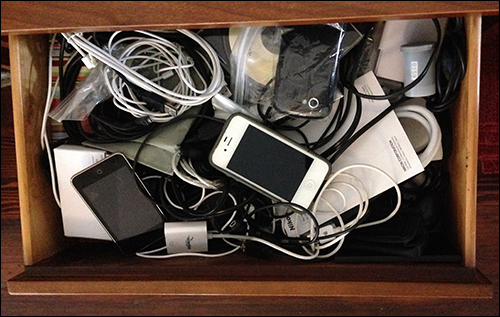The junk drawer. I’m going to hazard a guess that 99.9 percent of households have at least one for the things they don’t want to get rid of, but can’t find a good use for. And throughout the past couple decades, a new kind of junk drawer has emerged in many a home—mine included. This is the electronic junk drawer. Here’s a shot of my own embarrassing hoard.

It’s embarrassing because it’s wasteful. There’s gold in there—literally. There are also other valuable metals integrated into the circuit boards, but I’m referring to the sensors inside my used electronics. That’s a Samsung Nexus phone with a broken screen and a plethora of functioning sensors, including a Near Field Communication (NFC) module. That iPhone’s battery is worthless, but its accelerometer and GPS receiver are perfectly good. These components, and much of the rest of that electronic detritus, have value. Jim Poss knows this, and he’s started an IoT technology company based on mining that value from electronic junk drawers, as The Guardian reported earlier this month:

“If Jim Poss hadn’t dropped his phone in the bath while bathing his son, he might never have hit upon the idea for his business. While researching a cheap replacement for his waterlogged iPhone, he had an epiphany: the used phones sold online for $60 (£45) or less could be repurposed as Internet of Things sensors and used to form flexible, low-cost security and vehicle telematics systems.”
Modifi, the startup Poss co-founded with alumni from Oracle, Google and Amazon, is creating IoT sensor nodes from re-programmed smartphones. Here’s the pitch on the company website: “Instead of throwing them away (Dumb), we reprogram them to provide remote controls and cloud data storage so you can have new insights, economically (Smart).”
Modifi is selling two vertical solutions, one for fleet management and another for security. It provides customers with software that leverages the GPS receivers, cameras and other sensors in the phones, as well as mounting cases and shells that house the smartphones so they can be mounted for specific uses (such as security). The software encrypts the collected data before transmitting it to cloud-based accounts that the customers access.
According to The Guardian, Modifi is working with three customers that already manage 8,100 networked devices. It’s unclear whether every single one of those end points is actually an old smartphone pulled from an electronic junk drawer. But Modifi estimates that there are one billion smartphones sitting in junk drawers around the world, waiting for their next mission in life.
Modifi is part of what is sometimes referred to as the circular economy, in which the lifecycles of products and resources are seen in a cyclical rather than cradle-to-grave model. To read more about the circular economy and how well aligned the IoT industry is to play a role in it, check out this Expert View article by Lauren Roman.
Poss, by the way, knows a few things about making money from waste. He founded Big Belly, a company that in 2003 introduced a solar-powered trash compactor that periodically dampens trash bins’ contents, by integrating these into a city’s public trash bins. This enables them to hold significantly more refuse than conventional cans, thereby allowing the city to reduce trash-collection frequency and costs.
Later, Big Belly started networking its trash cans, turning them into IoT hubs and thus making collection even more efficient, while also providing a new platform for smart-city infrastructure. It’s what they call the Internet of Trash, and it’s also a growing field. Lots of manufacturers of trash and recycling collection bins are starting to morph into IoT hub providers. At present, more than 30,000 Big Belly cans are in use around the world.
I don’t know if Modifi’s repurposing effort will be as successful as Big Belly’s smart trash, but I do know that I’d be awfully pleased to empty my electronic junk drawer and put all those discarded gadgets to good use.
Mary Catherine O’Connor is the editor of IoT Journal and a former staff reporter for RFID Journal. She also writes about technology, as it relates to business and the environment, for a range of consumer magazines and newspapers.

